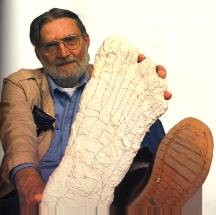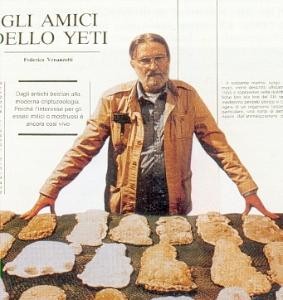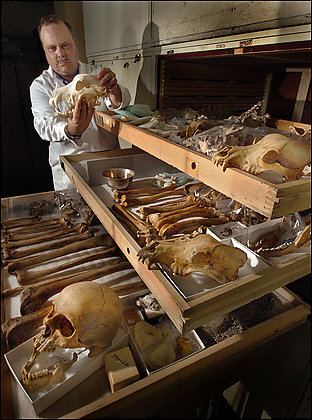
February 9, 2007

It’s only been five years, but it seems like yesterday and yet long ago. As Valentine’s Day comes rushing closer in 2007, a moment to recall Grover, the Ph. D. of Sasquatch…from my overview I wrote soon after he passed away in 2002.
^^^^^^^^^^^^^^^^^
Grover S. Krantz, an anthropologist who was never afraid to take the unpopular academic position that the primates which he called Sasquatch (he thought “Bigfoot” was not scholarly) actually exist, died peacefully, on the morning February 14, 2002, in his Port Angeles, Washington State home.
As the modern era’s first academically-affiliated physical anthropologist to actively involve himself in Bigfoot/Sasquatch research, Dr. Krantz was one of the most quoted authorities on the status of the controversy. He began his research in 1963, and it took him from the analysis of the Patterson-Gimlin film of 1967, to an examination of the Skookum body cast of 2000.

Krantz wrote or edited several papers on the Sasquatch, of a formal scholarly nature (published in Northwest Anthropological Research Notes) and four books, The Scientist Looks at the Sasquatch (Moscow: University Press of Idaho, 1977, with anthropologist Roderick Sprague), The Scientist Looks at the Sasquatch II (Moscow: University Press of Idaho, 1979, with Roderick Sprague), The Sasquatch and Other Unknown Hominoids (Calgary: Western Publishing, 1984, with archaeologist Vladimir Markotic) and Big Footprints (Boulder: Johnson, 1992), revised as Bigfoot Sasquatch Evidence (Seattle: Hancock House, 1999). Dr. Krantz, as an outspoken academic, was a focus of the 1999 documentary Sasquatch Odyssey (director Peter von Puttkamer), which also profiled the late Rene Dahinden, John Green, and Peter Byrne. While these men did not often get along, they formed the “Four Horseman of Sasquatchery,” the foundation of thought on these unknown hominoids in the Pacific Northwest from the 1960s onward.

Dr. Krantz was the primary North American spokesperson for the pro-stance of killing a Bigfoot to prove they exist. He will most be remembered, however, as the foremost proponent of the theory that the survival of the giant ape Gigantopithecus, recently thought to be extinct, is the source of modern Sasquatch and Bigfoot reports. Krantz created the first reconstructions of the full skulls of Gigantopithecus and Meganthropus, as well as restoring various elements of understudied Homo erectus finds. During the late 1990s, Dr. Krantz became one of the major supporters, in academia and in court, for the preservation for study of the disputed Kennewick skull which he theorized might have a non-Native American origin.
Grover S. Krantz, born in 1931, in Salt Lake City, grew up in Rockford, Illinois, then moved with his missionary family back to Utah when he was ten. Few knew or realized Krantz was raised as a member of The Church of Jesus Christ of Latter-day Saints (Mormon). Krantz went on to study at the Universities of Utah, California (B.A. 1955, M. A. 1958) and Minnesota (Ph. D. 1971), with a concentration in human evolution. He was a professor at Washington State University since 1968, until his retirement in the 1990s. During his retirement, he still taught one anthropology course per year, beamed via television back to Pullman, from his home in the Olympic Peninsula. He continued his research until his illness allowed him to do no more work.

Dr. Krantz was a physical anthropologist whose teaching and research had covered all aspects of human evolution, primarily of skeletal traits, but also the evolution of the human capacity for culture. He had visited many museums in Europe, China and Java to study original fossils and to make casts of some (Java) for distribution to other scientists. He had accumulated a major collection of such casts, including his own reconstructions of many of them. Dr. Krantz’s major non-Bigfoot anthropological works were Climatic Races and Descent Groups (1980), The Antiquity of Race (1981, 1994, 1998), The Process of Human Evolution (1982, 1995), and Geographical Development of European Languages (1988). Other publications included original work on such topics as Neanderthal winter survival, precision gripping of stone tools, language origins, mastoid function, tooth wear, mammal extinctions, sea-level changes, nonmigrations of hunting peoples, Neanderthal taxonomy, Ramapithecus as a female form, and pelvic evolution – all illustrated by Grover Krantz.
Dr. Krantz died from pancreatic cancer. The always active Grover Krantz went into decline soon after he told me on December 6, 2001: “Medicine men differ as to whether I have months or years to live.” Such reflected the final uphill battle that Grover faced in a life of challenges. Diane Horton, his wife, was with him constantly, to the end.
Grover S. Krantz’s candid assessments in hominology and towering vision in cryptozoology will be missed by the many people who have followed his work for decades, but his thoughts and concepts will remain to continue educating generations to come.
Following Krantz’s wishes, Diane Horton held no local services. Grover’s body, instead, was sent to the Body Farm at the University of Tennessee and then his skeleton was sent to the Smithsonian Institution along with most of his academic materials. As he helped students in life, his skeleton and materials will be available to serious scholars in death.

Smithsonian’s Museum of Natural History anthropologist David Hunt opens a green cabinet and pulls out a collection of dog and human bones. That’s Grover Krantz in the bottom drawer, and his skull is over to the left, up front. Hunt holds one of Krantz’s wolfhounds, which are also in the collection, according to Krantz’s wishes.
I fully accept the Patterson film. [Bigfoot’s loping gait is] consistent with a 500-pound biped. I’ve attempted to imitate it, and I really can’t do it worth a damn. – Grover Krantz, 1999
About Loren Coleman
Loren Coleman is one of the world’s leading cryptozoologists, some say “the” leading living cryptozoologist. Certainly, he is acknowledged as the current living American researcher and writer who has most popularized cryptozoology in the late 20th and early 21st centuries.
Starting his fieldwork and investigations in 1960, after traveling and trekking extensively in pursuit of cryptozoological mysteries, Coleman began writing to share his experiences in 1969. An honorary member of Ivan T. Sanderson’s Society for the Investigation of the Unexplained in the 1970s, Coleman has been bestowed with similar honorary memberships of the North Idaho College Cryptozoology Club in 1983, and in subsequent years, that of the British Columbia Scientific Cryptozoology Club, CryptoSafari International, and other international organizations. He was also a Life Member and Benefactor of the International Society of Cryptozoology (now-defunct).
Loren Coleman’s daily blog, as a member of the Cryptomundo Team, served as an ongoing avenue of communication for the ever-growing body of cryptozoo news from 2005 through 2013. He returned as an infrequent contributor beginning Halloween week of 2015.
Coleman is the founder in 2003, and current director of the International Cryptozoology Museum in Portland, Maine.
Filed under Bigfoot, CryptoZoo News, Cryptozoology, Obituaries, Sasquatch